XI
The philosophers have only interpreted the world, in various ways; the point is to change it.
-Marx
The Communist Manifesto and Its Parade of Marginalia
So I didn’t even make it through the first of the roughly 43,000 introductions before having an idea that paraphrasing Marx, was ‘hitherto unimaginable in its importance blah blah blah.’ This thought was so unimaginably important to humanity that it demanded I stop and sketch it out in connection with the reading and our HW for the week of scrapping the contents of a website . Here is the passage I worked with.
“Between March and July 1848 the Manifesto was printed in the Deutsche Londoner Zeitung, a democratic newspaper of the German emigrants. Already that same year numerous efforts were made to publish the Manifesto in other European languages. A Danish, a Polish (in Paris) and a Swedish (under a different title: “The Voice of Communism. Declaration of the Communist Party”) editions appeared in 1848. The translations into French, Italian and Spanish made at that time remained unpublished. In April 1848, Engels, then in Barmen, was translating the Manifesto into English, but he managed to translate only half of it, and the first English translation, made by Helen Macfarlane, was not published until two years later, between June and November 1850.”
So interesting, this moment before everything was as translatable as it is now. I want to explore this connected to Vannevar Bush’s ideas around accessing the human 'record' of knowledge in As We May Think, and elucidate what it really means to ‘translate,’ something digitally. I think this exploration would also be grounded in Walter Benjamin’s ideas about translation laid out in ‘The Task of the Translator.’
In many ways, I think that despite the technological advances, we are largely still confronting the same problem humans were confronting before translation was so available, which is how to really 'translate' something. That is really get the message of something across. The idea that simply storing and making available a text or document in a number of languages does not a full or functioning translation make. The user or reader has not been given the appropriate tools to interact with or understand the 'translated' version of a thing for many reasons, and perhaps chief among them is that the digital translations are most often poor simulacrum of their original source material which remove the contextual effectiveness of the original intervention by presenting it in a static form which renders it as only a portrait of an idea that once existed-as opposed to a dynamic and active part of the on going negotiation of the bounds of reality amongst people, mediated through culture and communication.
[su_box title=”note:” style=”noise”]
the next couple paragraphs are a development zone…at best. I am still working through these ideas and have a great deal of work to do before they are clear.—
[/su_box]
I love text dearly, and the ability to reproduce and share it is something I am almost constantly aware of and grateful for. But static black and white text, or any direct port of a written document on to a server and made available for copy reproduction 2, digitally have not, for they cannot, do the work of translating across a generational line the meaning and feelings and. effectiveness3 of the text.
For a text to be effectively translated for the 22nd century4 It must be understood in its own context as a Dramaturge might do for a play, and their presentation re-imagined to be 'accessible' or even possible of consideration for a person engaged in their human vocation of engaging in the processes the effect their lives.
The degree to which a text reproduction simulacrum is effective is certainly not binary, nor each archival version equal. Some of the factors are
- The ability for it to be used and put in conversation with other texts and media
- OCR
- A great and very usable form of digital archive text representations are ones that have been 'washed' that is prepared to be used in programming to really engage the possibility of their translation and continued engagement in the cultural meaning making process taken up by humans in their active involvement in the meaning making processes of their lives.
—
end experimental section
—
Ok, let’s talk about the thing I am going to make for this week’s homework! I am thinking about scraping the data from a website I often refer to and want to engage with people using as a source document. So I am going to use a website that hosts the text for the black panther party ten point plan., and try to programmatically prepare that text for use in dialogic activities between humans, mediated by computers through the use of intentional and interactive web environments.
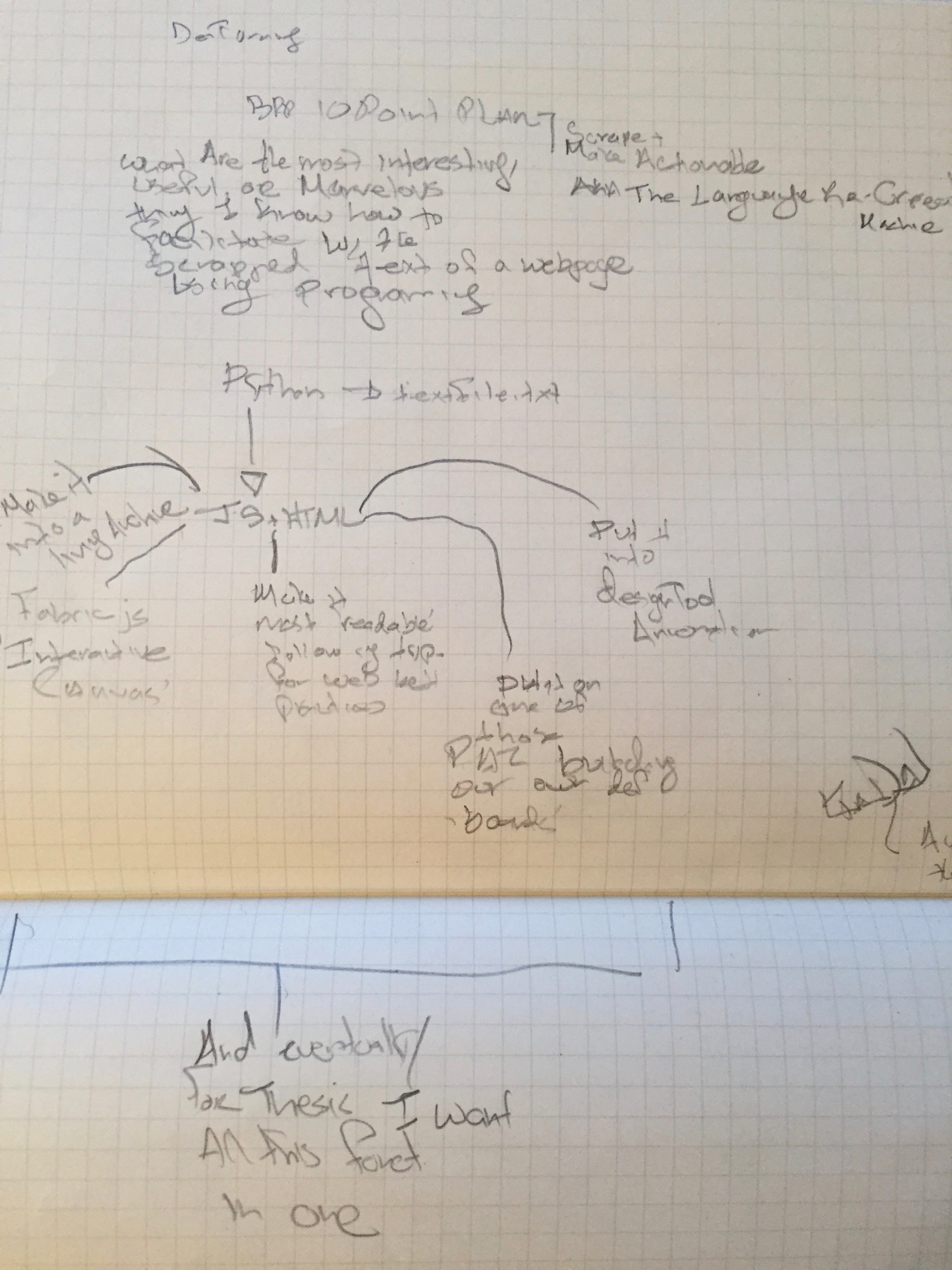
Here is an image of the project workflow I was working from.
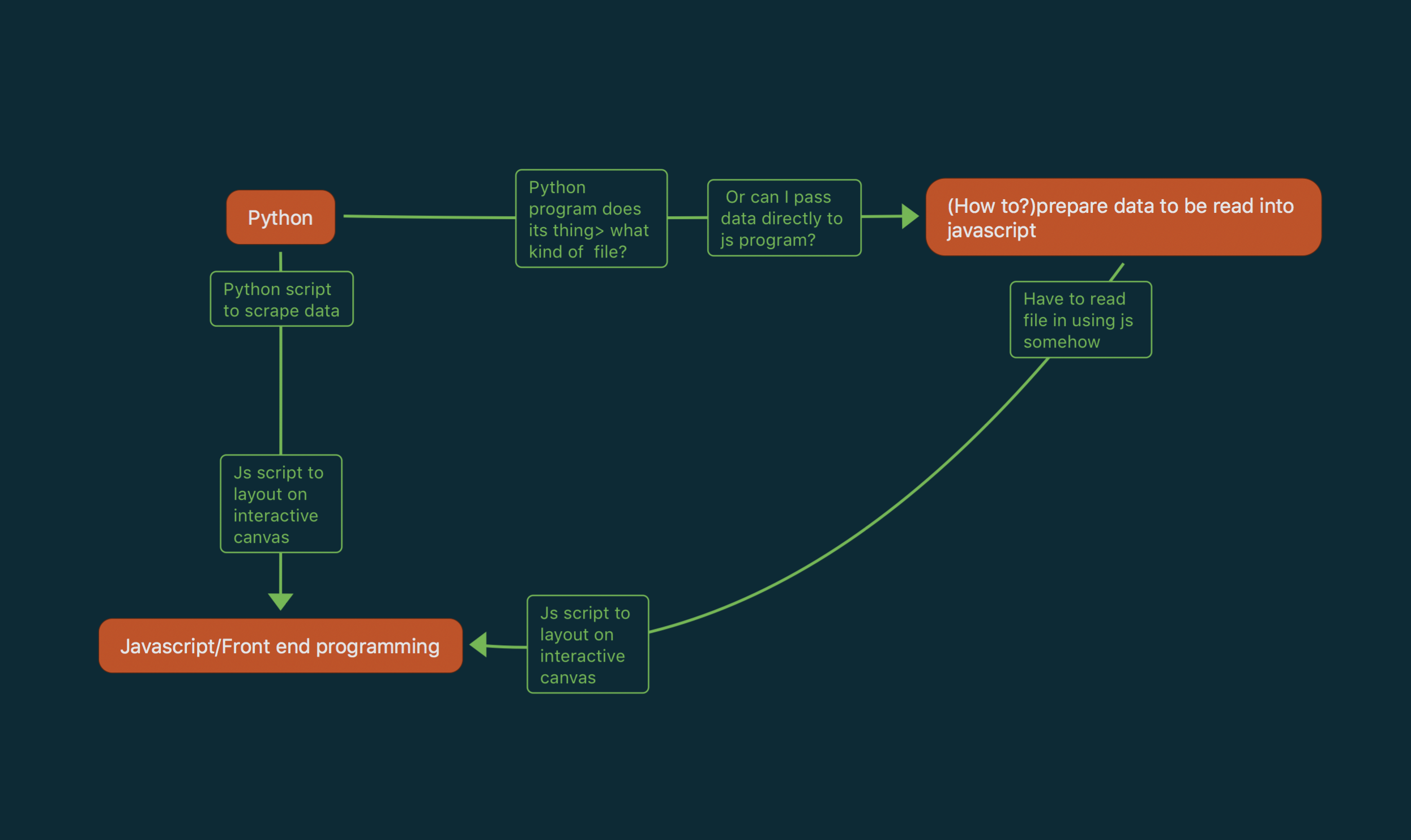
And here is one with the output brainstorm
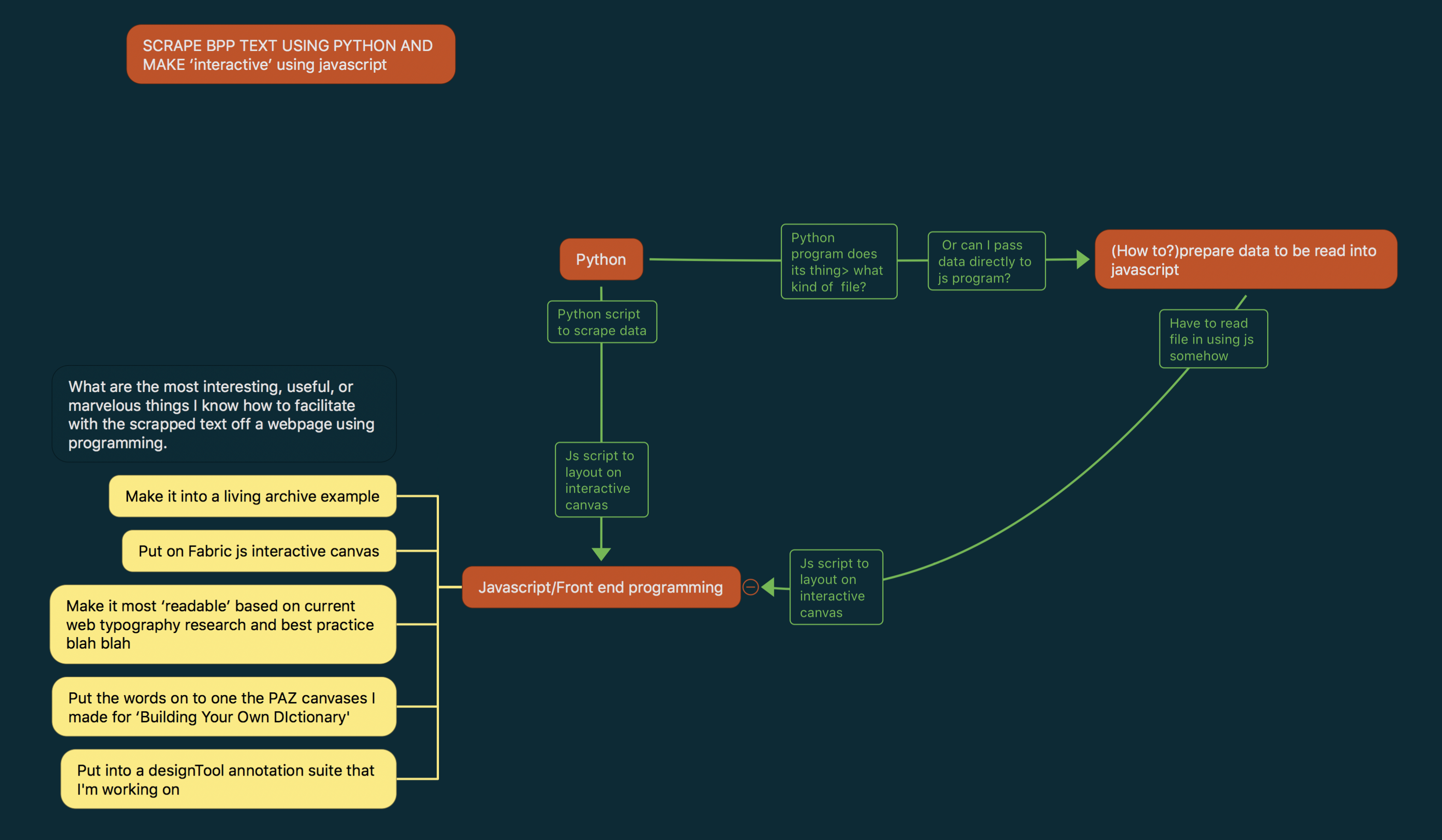
and you can see a full series of steps, including issues I encountered in the process on an ithoughts web hosted mind map here
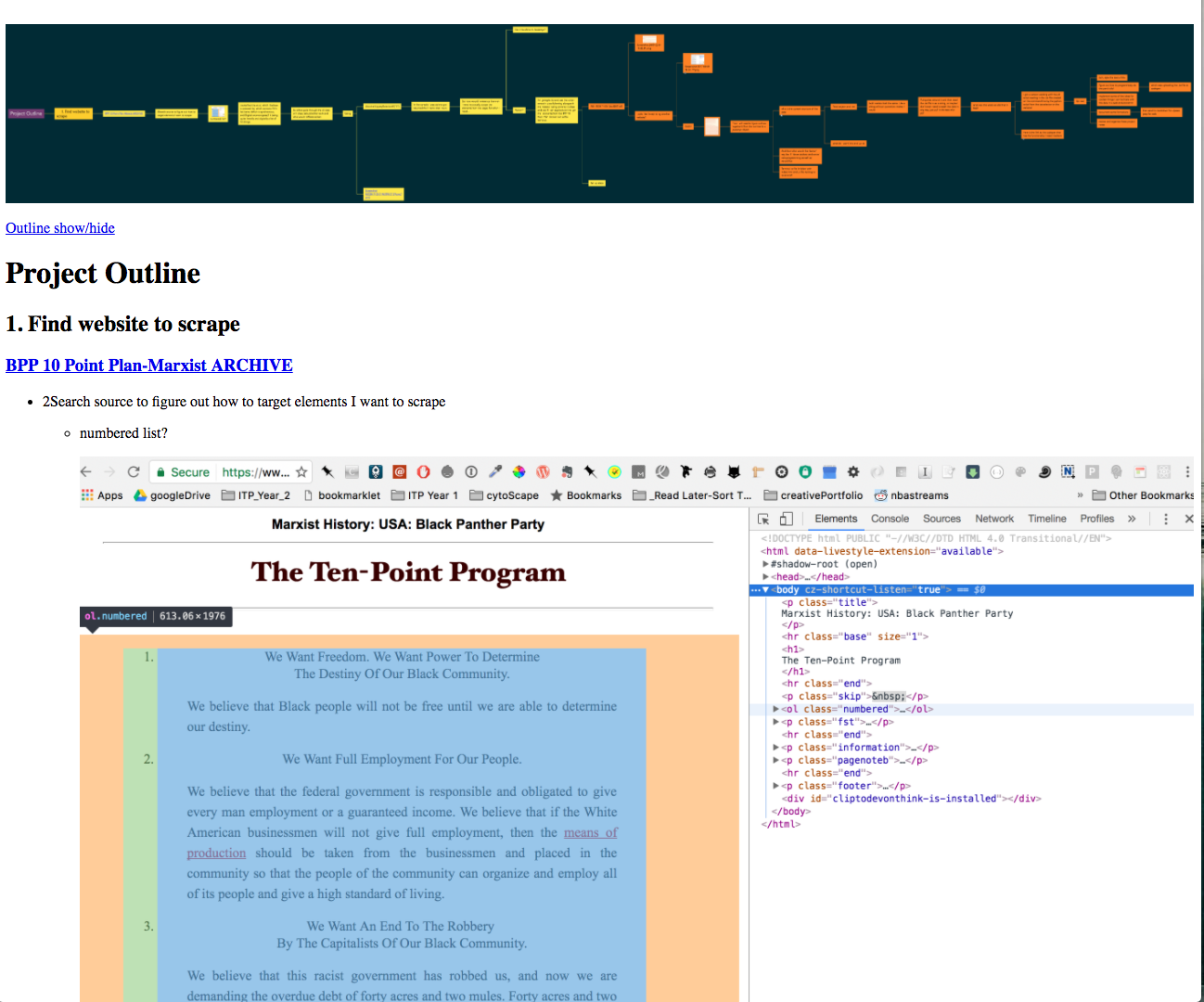
# Putting Together the Pieces
Ok so I have a python script working (based entirely on our in class work and example) that is scraping the text of the BPP 10 Point Plan, and I am at the point where I am trying to decide what to do with it, following my desire to have it prepared for dialogic use by humans in manipulating and recreation their world. Here is a quick reminder of my initial brainstorm on the question
The question: What are the most interesting, useful, or marvelous things I know how to facilitate with the scrapped to of a webpage using programming.
- Make it into a living archive example
- Put on Fabric js interactive canvas
- Make it most ‘readable’ based on current web typography research and best practice blah blah
- Put the words on to one the PAZ canvases I made for ‘Building Your Own Dictionary'
- Put into a designTool annotation suite that I'm working on
I would ideally work towards creating a system that implemented all these things, which I am interested in doing as part of my thesis project. For this weeks homework, I decided to integrate the scrapped data into an environment that I had already developed.
As part of my 30 for 30 web development experiment I did this summer, I created a piece that put an Audre Lorde text (originally a speech) and the BPP 10 point text on to an interactive canvas that users could engage with to create their own poem from the two found sources. This program, which you can see in the imagen below, pulled the source text directly from the html where I manually copy and pasted the sections I wanted into the body.
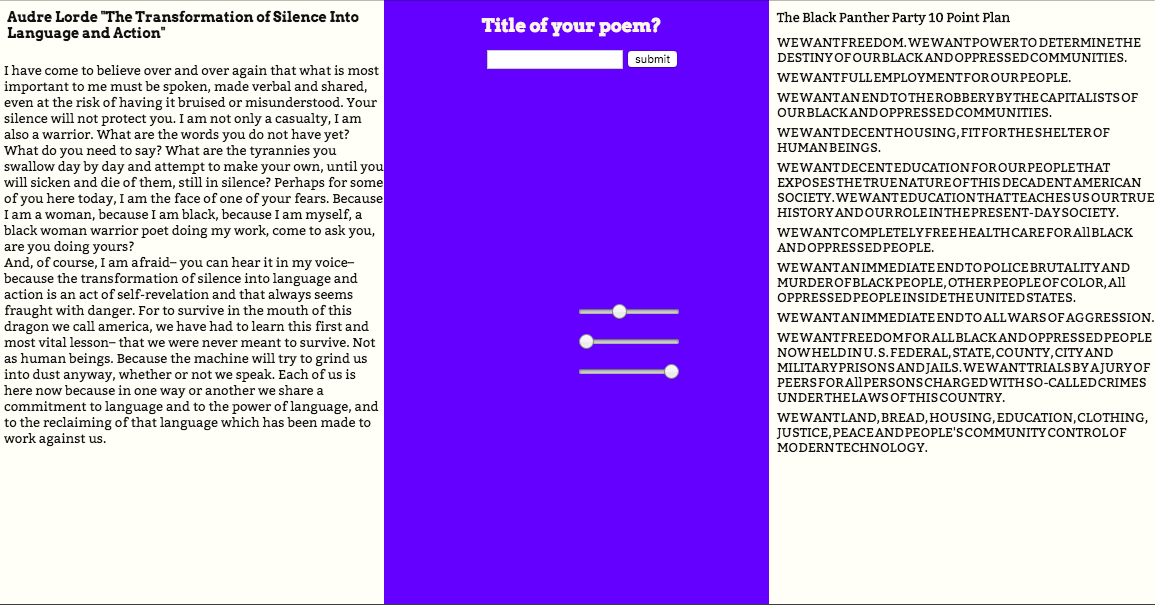
For this weeks project I am going to fork that piece and try to re-write the program to draw the ten point plan from the python –> javascript workflow being developed was part of this weeks homework assignment.
I was able to get the scraped data into a codepen by reading the resulting string into a p5 sketch using code I had written for programming A-Z last semester. Codepen below.
And here is the codepen for the forked version of the BPP 10 Point Plan and 10 points from the communist manifesto (our reading for the week) Refrigerator Magnet Poetry Mashup. Try dragging the words around!